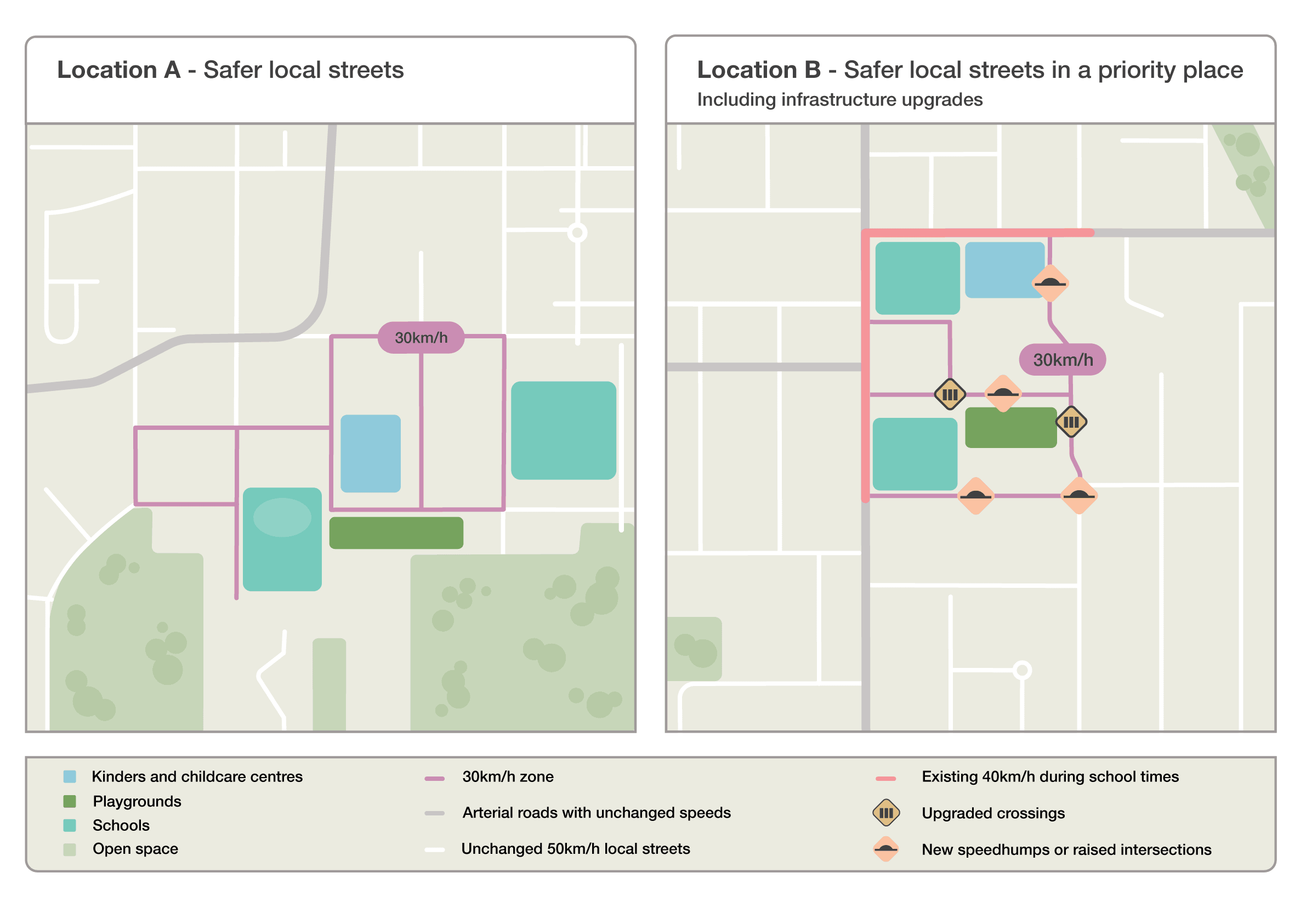Social media video to inform community discussion on 30km/h speed limits for local streets
The state’s independent infrastructure advisory body, Infrastructure Victoria, will provide governments with a social media video to help inform community discussion about reducing speed limits on local streets.
The video will be shown to the local government sector tomorrow (Thursday 20 November) at a briefing session for councils on Victoria’s infrastructure strategy 2025–2055, released by Infrastructure Victoria last week.
The updated infrastructure strategy is evidence-based and includes a recommendation to reduce speed limits to 30km/h on local streets, starting in places that children often visit, including around schools, playgrounds, childcare centres and kindergartens.
“National and international research evidence is clear. Slower speeds make streets safer for children and communities,” said Infrastructure Victoria Chief Executive Dr Jonathan Spear. “About 7 children die each year on Victoria’s roads and nearly 300 are seriously injured, mostly on local roads with speed limits of 50km/h.”
Dr Spear said community and stakeholder consultation on the draft 30-year strategy earlier this year led to the development of the social media video by the advisory body. “Feedback was positive with 78 per cent of submissions supporting the recommendation in full, or in part.
“The high level of support for this recommendation was a pleasant surprise given some of the public commentary," Dr Spear said. "We were all ears in terms of the submissions that were less supportive but many of them misunderstood what we were recommending.
“They thought we meant low speeds everywhere, across the whole road network, or they had the wrong idea that a lower speed limit means much longer journey times,” he said.
"There's really good evidence that’s not the case for local streets in cities and large towns. Drivers must stop or slow down in those streets for other traffic and stoppages such as traffic signals, stop signs, pedestrian crossings, cars parking, rail crossings, or in busy areas like shopping zones.”
The social media video features colourful, jellybean-type characters and follows two drivers, Remi and Sam, driving the same route on local streets. ‘Remi thinks faster means quicker. Sam just drives steady.’ The video explains ‘Australian research shows that lower speed limits on local streets have almost no impact on your travel time’.
Following the release of the draft 30-year infrastructure strategy, the Victorian Government made it easier for local governments to implement 30km/h zones around schools. The strategy is now final and recommends the government update its speed limit policy to include local streets around other places that children often visit, such as playgrounds and childcare centres.
The strategy recommends that lower speed limits should apply to local streets with current speed limits of 50km/h or less. It states: “We do not recommend these changes to roads with speed limits above 50km/h, such as main roads and highways, unless they are in areas of high pedestrian activity”.
Dr Spear said: “A pedestrian hit by a car at 50km/h has an 85 per cent chance of dying. At 30km/h this falls to 10 per cent. Lowering speeds from 50km/h to 30km/h on local streets has little effect on travel times but can make a huge difference to lives saved and injuries avoided.
“Schools, playgrounds, childcare centres and kindergartens are often close to people’s homes,” he said. “These are the easiest trips for people to switch from cars to walking or cycling. People, including young families, are more likely to do this where there are lower speed limits which give greater confidence that it is safe to use local streets.”
Dr Spear said it was hoped that local governments would use the video to inform and prompt discussion in local communities. “An important part of our role is to promote informed public debate on the infrastructure issues that matter,” he said. “We are encouraging local governments to use this video as one of their tools to support engagement with communities on 30km/h speed limits for local roads.
“In some parts of Victoria, we have seen local communities band together to successfully push for lower speed limits. Unfortunately, that’s usually prompted by accidents and tragic loss of life. We hope the video, together with the evidence we present in Victoria’s infrastructure strategy, helps encourage more communities to support 30km/h speed limits on local streets.”
Victoria’s 30-year infrastructure strategy tabled in Parliament
Victoria’s infrastructure strategy 2025–2055 provides 45 recommendations to the Victorian Government. It is a practical roadmap for the policies, reforms and projects that can deliver significant benefits and are most critical to Victoria’s communities, economy and the environment over the coming decades.
Infrastructure Victoria updates Victoria’s 30-year infrastructure strategy every 3 to 5 years. Community and stakeholder feedback, along with technical assessments and new evidence, also contribute to its development.
The completed strategy was tabled in the Victorian Parliament to inform the policies of all political parties. The Victorian Government is required to respond to the strategy’s recommendations within 12 months.
This is the third 30-year strategy produced since Infrastructure Victoria was created 10 years ago. It covers a broad range of sectors including transport, health, housing, energy, social infrastructure and the environment.
Visit www.infrastructurevictoria.com.au to read the strategy recommendations.
Media enquiries
Mandy Frostick mandy.frostick@infrastructurevictoria.com.au Ph: 0419 546 245
Editors please note: link to the video (with optional subtitles/closed captions), link to the video with embedded captions (for social media sharing) and a link to the supporting illustration for this strategy recommendation (both png and ai versions). Please contact us if you need help.
Fast facts
- Road trauma is a leading cause of death for children aged 1 to 14.
- An average of 35 pedestrians die each year on Victoria’s roads.
Figure 13: Simple changes can make streets safer
